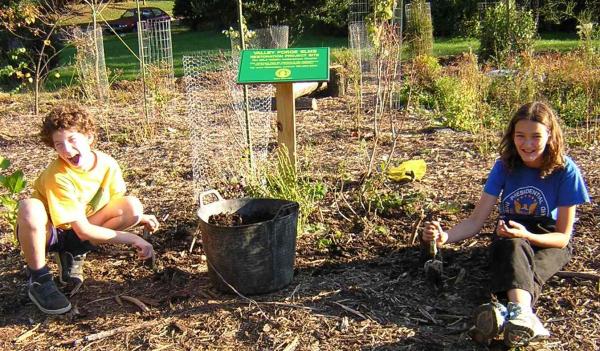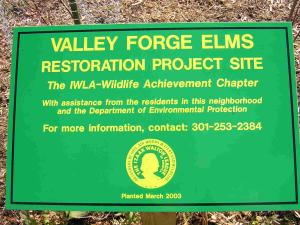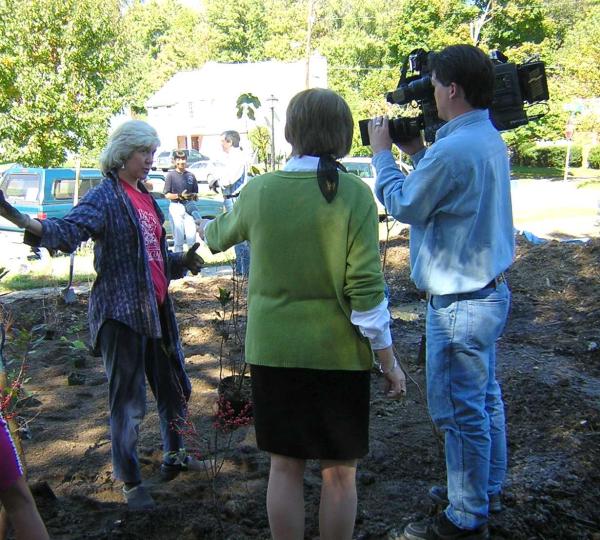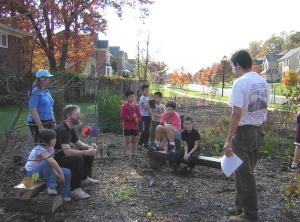


|

|
Brief History of the American Elm Park |
|
Kathy Michels November 3, 2003 |
Update August 2004 Update October 2005 |
Update November 2007 American Elm Tree Monitoring Results |

American Elm Park restoration site: The site is a public right of way that was part of a woodland adjoining a field until the early 1990s (just before we moved into our house across the street). It was always a wet woodland, apparently a small stream used to run through there and percolate into the ground, absorbed by the roots of trees and other vegetation that also kept the soil porous and spread with good organic matter from the leaves, twigs, etc, that fell to the ground. Then the site was clear-cut and repeatedly torn up by the developer Madison Homes. The topsoil and leaf mold layer were removed or irretrievably buried. All that was left was a sticky non-porous clay along with buried construction debris. Even though the area was finally seeded with grass, weeds overtook it. It was unmowable (unmaintainable) because of the half-buried debris; no lawn service would touch it, and the county could never cut more than a fraction of it before it damaged their machines.
The springs apparently remain, combining with all the run-off from the properties above and contributing to the ephemeral stream that runs down the east side of the site along the boundary with the yard on the east, making that adjoining property very soggy.
From the spring of 2000 until 2002, neighbors planted native trees and shrubs with the help of a Keep Montgomery County Beautiful (KMCB) grant. More than 30 trees and shrubs were planted and caged to help protect against deer (canopy and understory/flowering trees and many shrubs - about 10 different species, many difficult to find and establish). In spite of the difficult soil, drought, and deer, the trees and shrubs were becoming nicely established by August of 2002 when disaster struck in the form of a neighborhood vandal (dubbed the "tree terrorist"), he destroyed almost every tree and shrub on the site by using herbicide or by pulling or trampling them. He left the weeds, which were mostly invasive foxtail grass at the time.
The neighbors were horrified by the devastation but unwilling to give up. They approached the county for help again, and in the Spring of 2003 the American Elm Restoration site was established. The Izaak Walton League in concert with the Mo. Co. DEP, the Upper Sligo Civic Association and the Sligo Headwaters Civic Association planted and have been monitoring 4 disease-resistant Valley Forge Elms. See www.elmpost.org for more information about efforts to save the American elm. See www.usna.usda.gov/Newintro/american.html to learn about the Dutch elm disease tolerant Valley Forge elms.
 In early 2003, the neighbors also planted the middle of the site in early 2003 with a natural habitat garden consisting of nectaring and host plants donated by Sara Tangren of Chesapeake Natives Nursery and other friends. It was found that deer don't like obedient plant or foxglove beardtongue (penstomen), which bloomed profusely along with false sunflower (bidens), blue lobelia, ageratum, ironweed, rudbeckia and others?
In early 2003, the neighbors also planted the middle of the site in early 2003 with a natural habitat garden consisting of nectaring and host plants donated by Sara Tangren of Chesapeake Natives Nursery and other friends. It was found that deer don't like obedient plant or foxglove beardtongue (penstomen), which bloomed profusely along with false sunflower (bidens), blue lobelia, ageratum, ironweed, rudbeckia and others?
Friends of Sligo Creek, along with the neighborhood Civic Associations, agreed to co-sponsor a Montgomery County Department of Environmental Protection (DEP) Chesapeake Bay Trust Rainscaping project at the site on Oct 13th, 2003. The project consisted on installing a rain garden on the upper portion of the park. DEP helped with know-how and plant material, and three members of the department came to help on the day the garden was built. Dozens of members of the community also came out to help build the rain garden. The rain garden will immediately benefit that part of the Sligo Creek watershed as well as educate homeowners about stormwater run-off. The site will serve as a pilot demonstration project that will be monitored by the community.
News and Publications:
Photos from the October 13th workday event
"How to Build a Rain Garden" - a photo essay prepared using photos and experiences learned from this project.
All You Magazine January 2007 issue. The second feature in the "We Made a Difference" article is about Kathy Michels and her efforts at the American Elm Park.
Sponge Gardening: Soaking Up the Rain by Alison Gillespie
Reprinted with permission from the September/October 2005 issue of Washington Gardener magazine. To find out more about the magazine and to subscribe for just $18 a year, please visit www.washingtongardener.com.
One of the goals for the American elm Park is to educate homeowners about the benefits of rain gardens. The October 13th, 2003 workday was video taped by a Montgomery County video crew. The video footage will be used in a future cable television Green Man Show that addresses rain gardens.
| Kathy Michels being interviewed and taped for Green Man Show. | |
 |
The local civic associations are using the rain garden also as a learning tool. A "How to Build Rain Garden", using photos and our experience from the October 13th workday, has been prepared for posting on the local civic association web sites and the FoSC web site. We have found that the rain garden has also generated a lot of questions from the nearby homeowners about the purpose of the rain gardens. This has given us an opportunity to explain the problems associated with stormwater run-off.
| Nov. 1 kick off the Elm Tree Monitoring Project | |
 |
The park also features a natural habitat garden - nectaring and host plants in particular donated by Sara Tangren of Chesapeake Natives Nursery and other friends. The intent of this garden is to show that homeowner can create beautiful and interesting landscape features using native plants.